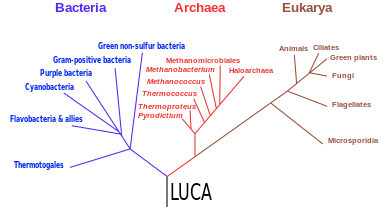
Back نظام النطاقات الثلاث Arabic Sistema de tres dominis Catalan Domäne (Biologie) German Sistema de tres dominios Spanish سامانه سهحوزهای Persian Domaine (biologie) French Sistema de tres dominios Galician Corys tree reamyn GV Sistem tiga domain ID 3역 분류 체계 Korean

The three-domain system is a taxonomic classification system that groups all cellular life into three domains, namely Archaea, Bacteria and Eukarya, introduced by Carl Woese, Otto Kandler and Mark Wheelis in 1990.[1] The key difference from earlier classifications such as the two-empire system and the five-kingdom classification is the splitting of Archaea (previously named "archaebacteria") from Bacteria as completely different organisms. It has been challenged by the two-domain system that divides organisms into Bacteria and Archaea only, as Eukaryotes are considered as a clade of Archaea.[2][3][4]
- ^ a b Woese CR, Kandler O, Wheelis ML (June 1990). "Towards a natural system of organisms: proposal for the domains Archaea, Bacteria, and Eucarya". Proceedings of the National Academy of Sciences of the United States of America. 87 (12): 4576–9. Bibcode:1990PNAS...87.4576W. doi:10.1073/pnas.87.12.4576. PMC 54159. PMID 2112744.
- ^ Cite error: The named reference
Gabaldónwas invoked but never defined (see the help page). - ^ Nobs, Stephanie-Jane; MacLeod, Fraser I.; Wong, Hon Lun; Burns, Brendan P. (2022). "Eukarya the chimera: eukaryotes, a secondary innovation of the two domains of life?". Trends in Microbiology. 30 (5): 421–431. doi:10.1016/j.tim.2021.11.003. PMID 34863611. S2CID 244823103.
- ^ Doolittle, W. Ford (2020). "Evolution: Two Domains of Life or Three?". Current Biology. 30 (4): R177–R179. doi:10.1016/j.cub.2020.01.010. PMID 32097647.